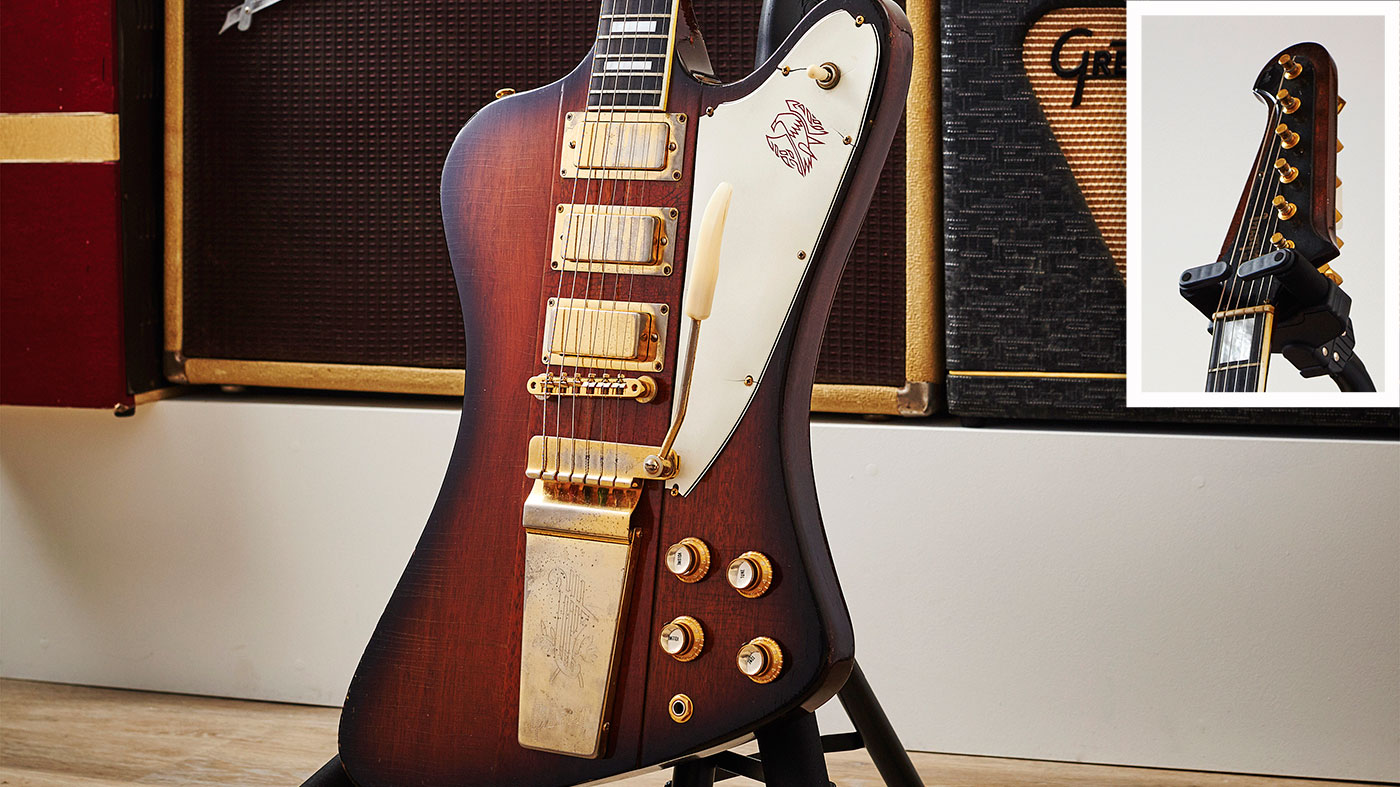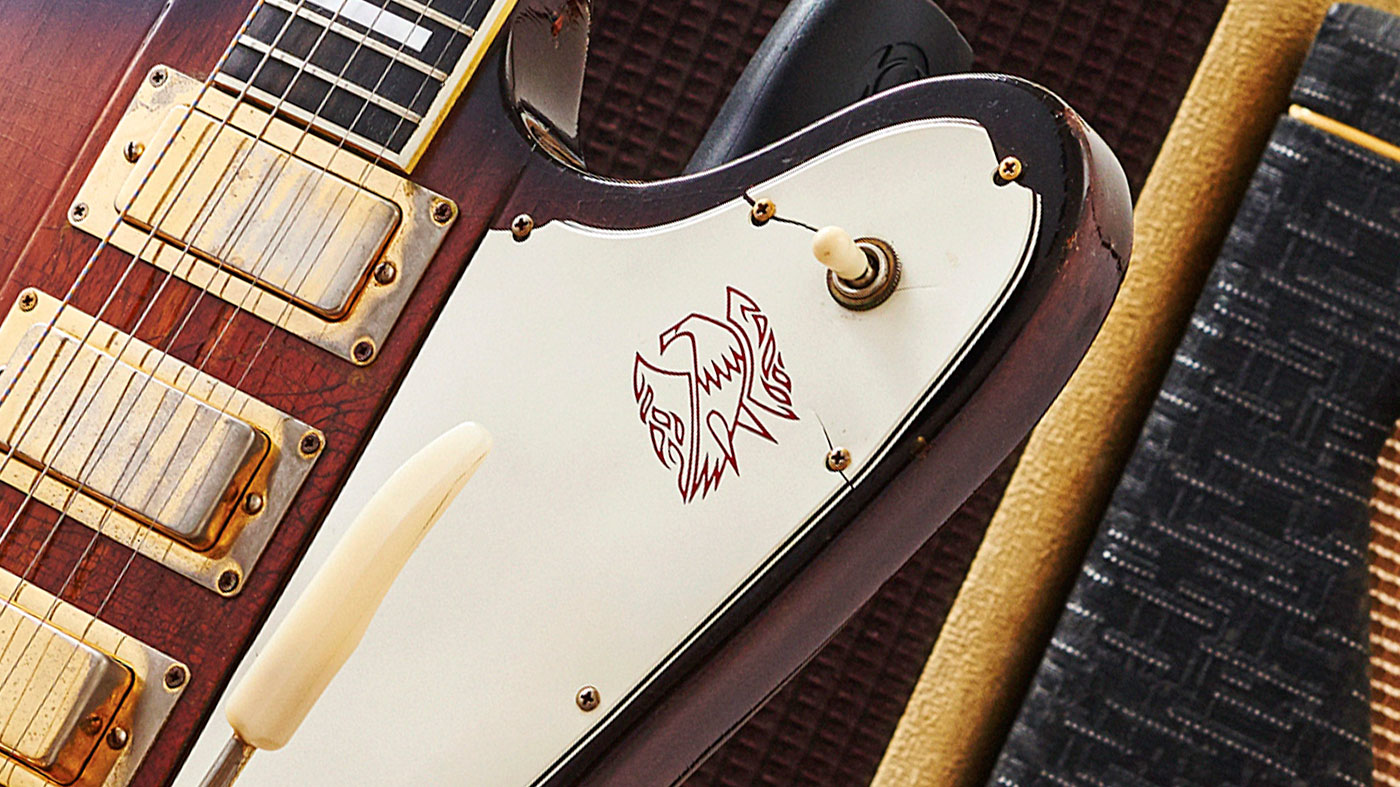Classic gear: Gibson Firebird VII
The Firebird VII blazes through the 60s at the top of the pecking order

Gibson’s Firebird electric solidbody guitars first appeared in 1963. Striking in appearance, they were perhaps the last in Gibson’s line of iconic and stylistically defining ‘rock’ guitars to arrive. Prior to this, in 1952, the Les Paul Model debuted as Gibson’s first solidbody and, by 1961, all the Les Paul variants had morphed into an SG-style body.
Meanwhile, in 1958, Gibson’s first semi-hollowbody electric, the ES-335, made its appearance along with the Flying V and Explorer, while the Melody Maker was released the following year. Further bolstered by their Epiphone brand of electric solidbodies, such as the Coronet, Crestwood/Custom and Wilshire from the late-50s onwards, Gibson’s catalogue continued to expand and their Kalamazoo factory began to appear increasingly colourful.
The original Firebirds are often referred to as ‘reverse’, meaning the treble horn extends further than the bass horn
In the early 60s, over at the Fender factory in Fullerton, things were also looking brighter, as they had long been winning customers over by indulging them with custom-colour guitars. By co mparison, Gibson’s relatively limited array of finishes - their traditional sunburst and natural, supplemented by a conservative assortment of black, white, gold, cherry and blonde/ ‘limed mahogany’ - left little in the way of choice. That would all soon change, however, with the release of the Firebird.
Gibson president Ted McCarty drafted in retired Ford and Chrysler designer Ray Dietrich to kickstart proceedings. With a profile similar to the Gibson Explorer, albeit with the sleek, angular geometry reminiscent of classic cars, the Gibson Firebird was released in 1963 with four models on offer: I, III, V and VII. In keeping with the car theme, Firebirds were offered in Golden Mist, Silver Mist, Frost Blue, Ember Red, Cardinal Red, Kerry Green, Polaris White, Pelham Blue, Inverness Green and Heather, in addition to sunburst.
The original Firebirds are often referred to as ‘reverse’, meaning the treble horn extends further than the bass horn, while the lower bass bout extends beyond the lower treble bout. Firebirds were the first Gibson solidbodies presenting a throughneck design, which extends to the bottom of the instrument, with the ‘wings’ of the body being glued onto the side.
Firebird was the first Gibson guitar to receive a mini-humbucker
Although originally angled in the opposite direction, Firebird headstocks were similar in shape to that of Fender’s and had banjo-style tuners installed across the treble side. Gibson had been manufacturing Epiphone branded guitars using mini-humbuckers since the late-50s and the Firebird was the first Gibson guitar to receive a pickup of this type, albeit with some unique technical differences - such as a metal cover and a dual bar magnet construction (as opposed to ‘mini PAF’-style adjustable polepieces).
The Firebird VII was the top instrument in the range and sported gold hardware, three bespoke pickups, a three-way pickup toggle, two volume and tone knobs and a bound ebony fingerboard with pearl block inlays. Gibson didn’t stand still for long, however, and in ’65 - beginning with a trickle of ‘transition specs’ - the Firebird VII was relaunched with a ‘nonreverse’- style body and headstock shape.
Want all the hottest music and gear news, reviews, deals, features and more, direct to your inbox? Sign up here.
With an extended bass horn and lower treble bout, along with right-angled tuners installed across the bass side of the peghead, the ‘non-reverse’ Firebird VII was a mirror image of its former self. A sliding pickup selector switch and glued-in neck with an unbound rosewood fingerboard and dot inlays replaced the model’s original, more decadent appointments and it remained in production throughout the rest of the 60s, until its discontinuation in 1970.
1964 Gibson Firebird VII
Serial number
Six digits on back of headstock; no ‘Made In USA’ stamp.
Headstock
‘Reverse’ direction; bevelled edge.
Hardware
Gold-plated Kluson banjostyle tuners, pickup covers, pickup surrounds, tune-omatic bridge, ‘leaf-and-lyre’ Deluxe vibrato, jack socket nut/washer, pickup selector washer, strap buttons and pickguard screws.
Neck
Mahogany two-piece through-neck; bound 22 jumbo fret ebony fingerboard with pearl block inlays; 24 ¾” scale; 1 11/16” nut width.

Plastics
White plastic pickup selector switch; gold-painted logo on black truss rod cover; three-ply (white/black/white) pickguard with bevelled edge and red engraved Firebird logo; 4x flared goldbase bonnet knobs with metal tone/volume caps.
Pickups
Three dual bar magnet Firebird mini-humbuckers, (“Patent No. 2,737,842”); tighter, punchier sound than regular mini-humbuckers; two volume and tone pots; front loading jack socket.
Body
‘Reverse’-style similar to Gibson Explorer with extended treble horn and lower base bout; mahogany side wings glued onto through-neck; raised middle section; standard sunburst finish.

The evolution of the Gibson Firebird VII
- Early 1963 - Gibson announce Firebird line prior to
- 1963 - NAMM show in Chicago
- 1963 - Earliest production ‘reverse’ models registered with through-neck construction, bound ebony fingerboard and pearl block inlays. 20 Firebird VII guitars registered shipped
- 1964 - Red engraved Firebird emblem appears on scratchplate (previously absent). 173 Firebird VII guitars registered shipped
- 1965 - ‘Reverse’ style phased out, ‘non-reverse’ model phased in with glued-in neck, rosewood fretboard and dot inlays; some transition headstock specs. 110 Firebird VII guitars registered shipped (‘reverse’ and ‘non-reverse’)
- 1970 - Firebird VII discontinued
- 1994 - Firebird VII Centennial released in limited run (serial numbers 1894-1994)
Rod Brakes is a music journalist with an expertise in guitars. Having spent many years at the coalface as a guitar dealer and tech, Rod's more recent work as a writer covering artists, industry pros and gear includes contributions for leading publications and websites such as Guitarist, Total Guitar, Guitar World, Guitar Player and MusicRadar in addition to specialist music books, blogs and social media. He is also a lifelong musician.


